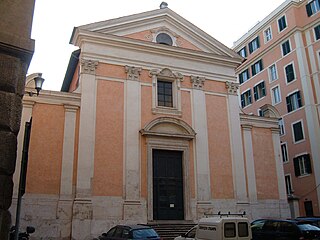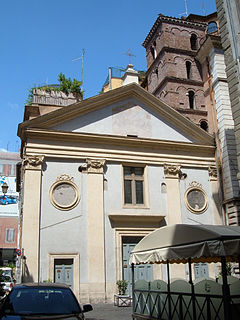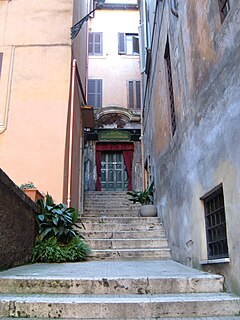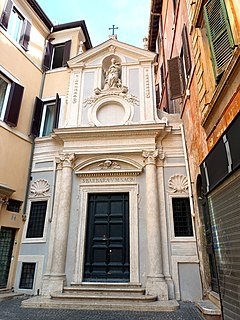
Ponte is the 5th rione of Rome, identified by the initials R. V, and is located in Municipio I. Its name comes from Ponte Sant'Angelo, which connects Ponte with the rione of Borgo. This bridge was built by Emperor Hadrian in 134 AD to connect his mausoleum to the rest of the city. Though Pope Sixtus V changed the rione limits, so that the bridge belongs now to Borgo, not to Ponte anymore, the area has kept its name and a bridge as its coat of arms.

Regola is the 7th rione of Rome, Italy, identified by the initials R. VII, and belongs to the Municipio I. The name comes from Arenula, which was the name of the soft sand that the river Tiber left after the floods, and that built strands on the left bank.

The Basilica of Saint Anthony of Padua al Laterano is a Roman Catholic titular church in Rome on Via Merulana, one block from the Obelisk of St. John Lateran. It was built for the Order of Friars Minor, who needed a new home after they were moved from Santa Maria in Ara Coeli to allow the construction of the Victor Emmanuel II Monument.

The Church of Saint Athanasius, also known as Sant'Atanasio dei Greci, is a Greek Catholic titular church located on Via del Babuino 149, near the Spanish steps, in the rione Campo Marzio of Rome, Italy.

San Giovanni Calibita is a Roman Catholic church located in the rione of Ripa on the Isola Tiberina, next to the Fatebenefratelli Hospital.

Piazza d'Aracoeli is a square of Rome (Italy), placed at the base of the Capitoline Hill, in the Rione X Campitelli.

The Chiesa di Santa Rita da Cascia in Campitelli is a deconsecrated church in Rome (Italy), in the rione Sant'Angelo; it is located in Via Montanara, at the crossroad with Via del Teatro Marcello. The church formerly rose on the preexisting church of San Biagio de Mercato, dating at least to the 11th-century. The remains of St Blaise putatively were discovered during the dismantling of Santa Rita.

Santo Spirito dei Napoletani is a Roman Catholic church on via Giulia, in the Regola rione of Rome. It was the national church of the Kingdom of the Two Sicilies and is now the regional church for Campania.

Santa Rita da Cascia alle Vergini is a Roman Catholic church in Rome, sited at the corner of Via delle Vergini and Via dell’Umiltà. Diagonal from the church on Via delle Vergini is the Teatro Quirino.

Santa Caterina da Siena is a church in Rome dedicated to Catherine of Siena. It is sited on via Giulia in the Regola district.

Santa Croce e San Bonaventura alla Pilotta or Santa Croce e di San Bonaventura dei Lucchesi is a church in Rome, sited on via dei Lucchesi in the Trevi district, between the Trevi Fountain and the Pontificia Università Gregoriana. It is Lucca's regional church in Rome.

Santa Maria della Concezione is a church in Rome, located on Piazza Campo Marzio in the Campo Marzio rione.

San Biagio della Pagnotta or San Biagio degli Armeni is a church in Rome, in the Ponte district, on via Giulia, near Palazzo Sacchetti. It is dedicated to Saint Blaise and is the national church of the Armenian community in Rome.

San Salvatore alle Coppelle is a church in Rome, on piazza delle Coppelle in the Sant'Eustachio district.

Natività di Gesù is a church on Piazza Pasquino in the Parione rione of Rome. It is the national church in Rome of the Democratic Republic of Congo.

Santi Simone e Giuda is a deconsecrated Catholic church in the center of Rome, Italy. It is important for historical reasons.

Santa Barbara dei Librai is a small Roman Catholic church in Rome, Italy. It was once known as Santa Barbara alla Regola after the rione in which it was located. Today it now considered within the rione of Parione, near the Campo de' Fiori.

Santa Maria in Monterone is a Roman Catholic church in Rome, Italy. Its suffix originates from the Sienese Monteroni family, whose patronage rebuilt the church and built a small hospice next to it for pilgrims from Siena. It is located on Via Santa Maria in Monterone in the Sant'Eustachio rione. Next to the church is a Redemptorist monastery, whose clergy manage the church.

The Monastery of the Viperesche is a former monastic building, still belonging to the Roman Catholic church, located on Via di San Vito, near the Arch of Gallienus, in the rione Esquilino, of Rome, Italy. The monastery complex, which includes the Oratory of Holy Mary of the Immaculate Conception now functions as a hostel. The monastery was in the past referred to as the Conservatory of the Holiest Conception or of the Viperesche.

Santa Maria in Montesanto is a church of Rome, in the Rione Campo Marzio, which stands in Piazza del Popolo, between Via del Corso and Via del Babuino. It is also known as the Church of the Artists. The church is popularly known as the twin church of Santa Maria dei Miracoli, though it shows significant differences especially in the planimetry.





















